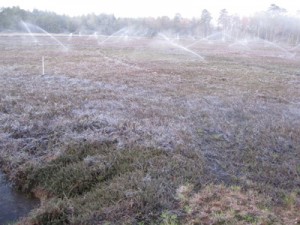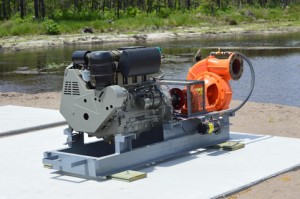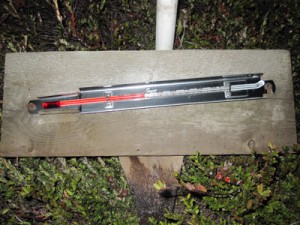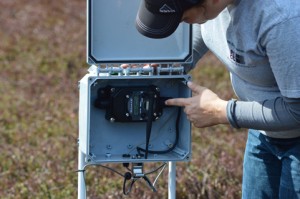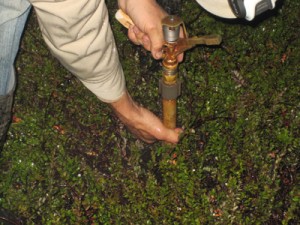Thanks to a warm spring, our team only just had their first full night of frost this season. One of the toughest things cranberry growers do is managing springtime frost conditions. In the spring, there is a danger to the crop when the temperature drops. Typically, a cranberry bog is built at a lower level than the land immediately surrounding it and the bog temperature can drop ten to fifteen degrees lower than the uplands. These conditions make monitoring bog temperature a top priority once the winter water comes off. It’s no exaggeration to say there would be no crop if we didn’t watch for frost on the bogs.
“Mike [Haines] does the scouting and gauges each bog based on growth, and we base our temperature threshold on that growth,” says COO Bryan vonHahmann. Because many of the plants weren’t so far along, the threshold was a lot lower, so the team didn’t have to run frost much until two nights ago. “I think we got a little rusty, because we haven’t done it in so long. Matt [Giberson] took precautions, though, and started all the systems at 2 the night before to make sure they were still working and everything was good.”
The first step is monitoring the temperature. Each bog has a thermometer (usually located in the coldest section) that requires frequent checking throughout the first part of the night. Once the temperature drops to between 33 and 35 degrees Fahrenheit (depending on the stage of growth), it’s time to turn on the pumps. More than forty years ago we used to flood the bogs to prevent frost damage; we now use sprinklers instead. When the water from the sprinklers freezes on the vines, it controls the temperature well enough to keep them from harm. It’s also necessary to check the surrounding reservoirs and canals to make sure that the water supply is sufficient to supply the pumps. That can take some time, and doesn’t always need to be done all at once. Depending on location and conditions–is the bog surrounded by woods? Where is the wind coming from? Is the sky clear or overcast?–some will be started earlier than others.
Fortunately, our ongoing automation process is helping make this easier. “We have roughly 50 Joe Lord thermometers out there and probably 80 to 90 analog thermometers,” Bryan says. In some bogs, there is one of each type. “The automated thermometer gives us the initial indication that the temperature is dropping. When it hits the first threshold, it sends the notification, and Matt sends out 3 to 4 guys to look at the analog thermometers. When the 2nd alarm goes off he’s probably calling more people.” We haven’t maximized everything the new system can do for us yet, but as Bryan says, “We’re slowly walking into the technology.” The goal, of course, is to fully automate the system, and we’re getting there! Even with only partial automation we’re already increasing our efficiency as well as saving wear and tear on equipment.
Once the pumps all started, though, the work isn’t over. The next thing is making sure all the sprinklers are working correctly. This means driving around to check they’re running at full capacity. It may also sometimes be necessary to repair the sprinklers, as they won’t run at full capacity if something is blocking the line. This happens more frequently when the systems first start running, and becomes less of an issue after a few cold nights.
“The really interesting thing is seeing how air patterns and flow truly affect temperature,” Bryan says. “One end of a bog could be 34 and the other end at 39, so in some cases we might not start an adjacent system in order to limit water we put on beds to avoid rot. At the same time, though, the beds need the frost protection or we don’t get a crop at all.” It’s a delicate balance and takes some decision making. “Today people are out scouting to check damage; we did get some, but feel the plants will grow out of it. So we’ll work on refining our process, set the threshold at a higher temp as the plants grow and need more protection. A warm spring might have us out of practice, but it’s been good!”

